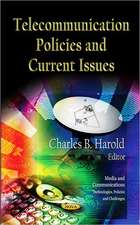Telecommunications Network Planning: Centre for Research on Transportation
Editat de Brunilde Sansò, Patrick Sorianoen Limba Engleză Hardback – 30 noi 1998
Telecommunications Network Planning will benefit both telecommunications practitioners looking for efficient methods to solve their problems and operations researchers interested in telecommunications. The book examines network design and dimensioning problems; it explores Operation Research issues related to a new standard Asynchronous Transfer Mode (ATM); it overviews problems that arise when designing survivable SDH/SONET Networks; it considers some broadband network problems; and it concludes with three chapters on wireless and mobile networks. Leading area researchers have contributed their recent research on the telecommunications and network topics treated in the volume.
| Toate formatele și edițiile | Preț | Express |
|---|---|---|
| Paperback (1) | 640.37 lei 43-57 zile | |
| Springer Us – 29 oct 2012 | 640.37 lei 43-57 zile | |
| Hardback (1) | 644.63 lei 43-57 zile | |
| Springer Us – 30 noi 1998 | 644.63 lei 43-57 zile |
Preț: 644.63 lei
Preț vechi: 758.38 lei
-15% Nou
Puncte Express: 967
Preț estimativ în valută:
123.35€ • 129.11$ • 102.67£
123.35€ • 129.11$ • 102.67£
Carte tipărită la comandă
Livrare economică 31 martie-14 aprilie
Preluare comenzi: 021 569.72.76
Specificații
ISBN-13: 9780792383970
ISBN-10: 0792383974
Pagini: 294
Ilustrații: XIX, 270 p.
Dimensiuni: 155 x 235 x 21 mm
Greutate: 0.54 kg
Ediția:1999
Editura: Springer Us
Colecția Springer
Seria Centre for Research on Transportation
Locul publicării:New York, NY, United States
ISBN-10: 0792383974
Pagini: 294
Ilustrații: XIX, 270 p.
Dimensiuni: 155 x 235 x 21 mm
Greutate: 0.54 kg
Ediția:1999
Editura: Springer Us
Colecția Springer
Seria Centre for Research on Transportation
Locul publicării:New York, NY, United States
Public țintă
ResearchCuprins
1 Introduction.- 1.1 Introduction.- 1.2 Survey.- 1.3 Relaxations for the Fixed-Charge Problem.- 1.4 Conclusion.- References.- 2 Using Hop-indexed Models for Contrained Spanning and Steiner Tree Models.- 2.1 Introduction.- 2.2 A Hop-Indexed Formulation for the Steiner Tree Problem.- 2.3 A Hop Dependent Multicommodity Flow Formulation for the Spanning/Steiner Trees with Hop Constraints.- 2.4 A Hop-Indexed Flow Based Model for Capacitated Spanning Trees.- 2.5 Conclusions.- References.- 3 Hierarchical Two Level Location Problems.- 3.1 Introduction.- 3.2 Formulations for the Uncapacitated Problem.- 3.3 Solution Methods.- 3.4 Numerical Results.- 3.5 Formulation for the Capacitated Problem.- 3.6 Solution Methods.- 3.7 Numerical Results.- 3.8 Conclusion and Perspectives.- References.- 4 Multi-hour Dimensioning in Non-hierarchical Telecommunications Networks.- 4.1 Introduction.- 4.2 Literature Review.- 4.3 The Network LP Model.- 4.4 Applying the Primat-Dual Algorithm to Dimensioning.- 4.5 Solution of the Restricted Primal.- 4.6 Numerical Results.- 4.7 Conclusions.- References.- 5 Issues in ATM Network Planning: An Operations Research Perspective.- 5.1 Introduction.- 5.2 Why ATM?.- 5.3 Main Features of ATM.- 5.4 Design Issues.- 5.5 Conclusions.- References.- 6 The Common Structure of Packet - and Circuit-Switched Network Synthesis.- 6.1 Introduction.- 6.2 Single-Service Packet-Switched Networks.- 6.3 Single-Service Circuit-Switched Networks.- 6.4 Multi-Service Packet-Switched Networks.- 6.5 Multi-Service Circuit-Switched Networks.- 6.6 Conclusion.- References.- 7 Loss Models for Broadband Networks with Non-Linear Constraint Fuctions.- 7.1 Introduction.- 7.2 Separable Multiplexing for a Single Link.- 7.3 Separable Multiplexing in Networks.- 7.4 Performance Evaluation.- 7.5 Performance Comparisons.- 7.6 Numerical Study.- References.- 8 Reliability Issues In Telecommunications Network Planning.- 8.1 Telecommunications Networks.- 8.2 Reliability and Performability.- 8.3 Applications to Network Design.- 8.4 Future Prospects.- References.- 9 Design and Dimensioning Of Survivable Sdh/Sonet Networks.- 9.1 Introduction.- 9.2 SDH/SONET Networks.- 9.3 Network Survivabiiity.- 9.4 Reserve Network Dimensioning.- 9.5 Self-Healing Ring Network Design.- 9.6 Conclusion and Perspectives.- References.- 10 Comparative Methods and Issuses in Design of Mesh-restorable STM and ATM Networks.- 10.1 Introduction.- 10.2 Prior Work.- 10.3 Capacity Design of STM Path Restorable Networks.- 10.4 Proposed Design Method for ATM VP-Based Path Restorable Networks.- 10.5 Summary.- References.- 11 Fault Tolerant Virtual Path Layout: Optimization Models.- 11.1 Introduction.- 11.2 Broadband Multiclass Networks.- 11.3 Modeling Issues.- 11.4 Integer Programming Formulations.- 11.5 Solution Methods.- 11.6 Conclusions.- References.- 12 Survey of Research Issues In Leo/Meo Based Global Mobile Communication Systems.- 12.1 Introduction.- 12.2 A Research Agenda.- 12.3 GEO/LEO/MEO When Should Each System Be Used?.- 12.4 Discussion.- References.- 13 Mathematical Models and Exact Methods for Channel As-Signment in Cellular Networks.- 13.1 Introduction.- 13.2 Statement of the Channel Assignment Problem.- 13.3 Literature Survey.- 13.4 A First Integer Programming Formulation.- 13.5 A Column Generation Integer Programming Formulation.- 13.6 Computational Experiments.- 13.7 Concluding Remarks.- References.- 14 Tile Covers, Closed Tours and The Radio Spectrum.- 14.1 Introduction.- 14.2 Description of the Problem.- 14.3 Closed Tours.- 14.4 Tile Covers.- 14.5 Conclusions.- References.











